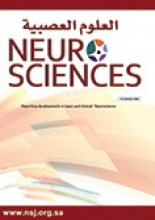Abstract
OBJECTIVE: Ascorbic acid is a powerful antioxidant and protects against lipid peroxidation in cerebral membrane. The objective of the study was to investigate protective effects of ascorbic acid on lipid peroxidative damage and perturbation of enzymes, glucose-6-phosphate dehydrogenase (G6PDH) and acetylcholinesterase (AChE) in discrete regions of rat brain after vanadium exposure.
METHODS: This study was carried out at Al-Arab Medical University, Benghazi, Libya, from 1995 to 1996. To investigate the effect of this vitamin on vanadium neurotoxicity in brain, adult rats were injected with L-ascorbic acid (1.0 g/kg body weight) and elemental vanadium (2.5 mg/kg body weight) alone or concomitantly for 8 consecutive days by the intraperitoneal route.
RESULTS: Vanadium intoxication significantly enhanced the occurrence of lipid peroxidation in discrete regions of rat brain. The increase in lipid peroxidation was inhibited by ascorbic acid treatment. On the other hand, ascorbic acid content was higher, but the activity of G6PDH and AChE was significantly inhibited in discrete regions of rat brain after vanadium neurotoxicity. Interestingly, however, co-administration (L-ascorbic acid + vanadium) reversed the levels of ascorbic acid together with the activity of G6PDH and AChE towards normal values. The neurohistopathology showed that vanadium is involved in an interaction with myelin and deleterious effect of metal resulted in edema and marked vacuolation of white matter or segmental de-myelinantion in the hypothalamus region of rat brain. Ascorbic treatment, however, did not show any effect on histopathological changes.
CONCLUSION: These results suggested that vanadium neurotoxicity initiated lipid peroxidative damage and interferes with enzymes, G6PDH and AChE, in rat brain. These events may lead to sensorimotor dysfunctions and axonal degeneration. On the other hand, ascorbic acid therein reduced the toxicity of vanadium.
- Copyright: © Neurosciences
Neurosciences is an Open Access journal and articles published are distributed under the terms of the Creative Commons Attribution-NonCommercial License (CC BY-NC). Readers may copy, distribute, and display the work for non-commercial purposes with the proper citation of the original work.






